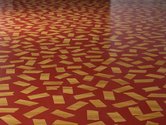John Hurrell – 3 March, 2022
This is a deceptively complex exhibition because of all the layering of references and oscillations of interpretation. It is hard to decide what to examine and what to ignore. With so many options tracking down differently connected pathways of meaning and action, two courses in particular (one elucidated by Simmons and Barber) seem the most useful. Two threads of interpretative response: ‘club sandwiches' or semiotic chordal triplets that stack chosen possibilities in clusters; that vertically prioritise elements.
Andrew Barber is well known for his chromatically restrained, elegantly streaky landscapes, pulsing tartan abstractions, sprawling patterned floor paintings, and trapezoid tennis court images. He hasn’t shown in Auckland for some time, so it is good to see now what this energetic, versatile, ex Gambia Castle artist (also a house painter) is up to.
In this upstairs Two Rooms exhibition, an installation, a plenitude of densely layered (highly ambiguous) morphing tropes abound: a ship; a wreck that is also a ruined planet; red sea that is clay-ochred land or maybe a transporting river; paintings that are sails, bushman shirts, or gridded blankets serving as realty charts; fake floors depicting floating kauri planks or embedded Ravenna bricks; a twenty-first century ‘ship of fools’ or Géricault‘s nineteenth century survivors’ raft—and heaps more from pre-colonial and colonial history, in terms of botanical and ornithological annihilation within the lowland bush, all pointing to our planet’s climate and ecological crisis.
Three elements (three painted artworks) fit together to collectively make up a fourth installational work: Shipwreck (the ship’s hull adrift on rocks, with ‘bits’ of the plank floor strewn in the sea); Stiff Blanket (Monocultural Agriculture) (the suspended bushman’s shirt-‘sail’ attached to the ceiling); Study (Bloodlines) (for a solution, the restorative plan on the wall).
The underpinning argument for the selection of the three works—as set out by Laurence Simmons in his gallery essay written in close discussion with the artist—is the eco-historical account of the damaging effects of colonial farming and milling (deforestation plus extravagant hunting) given by Geoff Park in his 1995 book, Ngā Uruora: The Groves of Life.
This is a deceptively complex exhibition because of all the layering of references and oscillations of interpretation. It is hard to decide what to examine and what to ignore. With so many options tracking down differently connected pathways of meaning and action, two courses in particular (one elucidated by Simmons and Barber) seem the most useful. Two threads of interpretative response: ‘club sandwiches’ or semiotic chordal triplets that stack chosen possibilities in clusters; that vertically prioritise elements.
One sets out or exposes key aspects of the crisis of a crashed ship that in an emergency becomes a raft, setting out the problem; the other elucidates the solution.
The first (in thinking of global catastrophe) brackets together the Swanndri bushman’s shirt / the spinning kauri plank fragments of the ruined ship / the highly competitive uncooperative (individualistic) zeal of a sport like tennis. The second (in order to get the ‘ship’/planet off the rocks), has the checkered shirt turn into a sail to enable release by sea or land via raft / a solid path or road out by way of Ravenna bricks / for a long term remedy focussed on kokowai (red ochre) that symbolises the blood of Ranginui (the Sky Father) and Papatūānuku (the Earth Mother), a declared ‘bloodline’, clay that denotes tapu in the first instance of a game of tennis, and perhaps in the second, an iwi for each district to repair the local ecological damage.
So we have a split interpretation of multiple images: a prognosis and a course of action, a proposed solution to a now, already very apparent calamity. A suite of paintings that with its symbolic floor, sail and navigation chart, provides vectors for guidance, conceptual railings for reassurance.
John Hurrell







 Two Rooms presents a program of residencies and projects
Two Rooms presents a program of residencies and projects Advertising in this column
Advertising in this column



This Discussion has 0 comments.
Comment
Participate
Register to Participate.
Sign in
Sign in to an existing account.